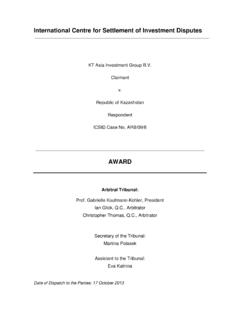Transcription of LIFE CYCLE COST ANALYSIS N -R B - Dovetail Partners
1 L IFE C YCLE C OST A NALYSIS. OF N ON -R ESIDENTIAL B UILDINGS. DR. JIM BOWYER. KATHRYN FERNHOLZ. DR. STEVE BRATKOVICH. DR. JEFF HOWE. DR. SARAH STAI. MATT FRANK. 21 OCTOBER 2013. Dovetail Partners Page 2 10/21/2013. life CYCLE cost ANALYSIS of Non-Residential Buildings Executive Summary The goals of this report are to clarify the differences between life CYCLE cost ANALYSIS (LCCA) and life CYCLE Assessment (LCA), summarize what is known about the life CYCLE costs of non-residential wood construction, compare the life CYCLE costs of wood structures to those of other materials, and review processes for conducting life CYCLE cost analyses on structural systems or whole buildings. Summaries of LCCA resources are also provided. Among the findings of this report are: Published life CYCLE cost ANALYSIS information for commercial buildings is sparse, particularly for wooden structures. LCCA is required for federal buildings.
2 life CYCLE environmental costs (impacts) are not considered in LCCA in current practice, indicating a clear difference between LCA and LCCA as currently structured. Current indices of the useful lives of various products allocate lower useful lives to wood than other materials without clear basis for any of the chosen values. Despite a pervasive perception that the useful life of wood structures is lower than buildings of other materials there is no meaningful relationship between the type of structural material and average service life . The combined lack of LCCA research on wood use in construction and the common availability of what appear to be non-research based estimates of useful lives of materials can create an unwarranted bias against the use of wood in structures. Development of definitive, research-based information on durability/longevity of wood structural and non-structural elements used in various building applications is needed.
3 Background life CYCLE cost ANALYSIS (LCCA) as applied to buildings, sometimes also referred to as value engineering or life CYCLE costing, involves accounting for all costs related to construction, operation, maintenance, and disposal at the end of the useful life of a structure. The purpose is to provide a basis for selection of the most cost -effective design alternative over a particular time frame, taking into account anticipated future costs as well as initial costs of construction. LCCA is particularly suitable for the evaluation of building design alternatives that satisfy a required level of building performance, especially when investment, operating, maintenance, and repair costs differ, and/or when alternative designs may have different expected service lives. life CYCLE costing has long been used in the United States for evaluation of design alternatives in highway and bridge construction.
4 However, application to design of buildings in general is much more recent, led by requirements of the federal government, several states, and a number of educational institutions. Dovetail Partners , INC. Dovetail Partners Page 3 10/21/2013. Despite the similarity in the acronyms LCCA and LCA, there is no relationship between techniques currently used in life CYCLE cost ANALYSIS and life CYCLE assessment. In LCCA, the focus is entirely on factors that result in bottom-line financial performance. Environmental costs, such as those linked to emissions associated with building materials or building operations (greenhouse gases, or emissions that contribute to smog formation, acidification, eutrophication, or human health impacts) are currently not considered in life CYCLE costing. LCA examines a full range of inputs, emissions, effluents, and wastes that may or may not directly impact financial performance of a particular project, but which have implications for broader societal costs as well as the local, regional, and global environment.
5 LCCA in building Design life CYCLE costing was developed by the Department of Defense (DOD). Requirements for consideration of life CYCLE costs in government projects began with a mid-1960s study by the Logistics Management Institute for the Assistant Secretary of Defense for Installations and Logistics. This led to a series of guidelines for DOD procurement, and then to DOD Directive in 1971 that established requirements for life CYCLE costing for all major defense systems acquisitions. In 1978, Congress passed the National Energy Conservation Policy Act that requires every new federal building to be life CYCLE cost effective1 (Dhillon 1989). Today, all federal agencies are required to use life CYCLE cost ANALYSIS in project evaluation. LCCA is described in documents supporting the Federal Energy Management Program as particularly suitable for the evaluation of building design alternatives that satisfy a required level of building performance, but that may have different initial investment costs; different operating, maintenance, and repair costs; and possibly different service lives (Fuller and Petersen 1995).
6 As noted in an LCCA user guide published by King County, Washington (King County 2011), in addition to direct costs of a building such as costs of construction, energy costs, building renewal and replacement, and operation and maintenance costs, LCCA can also take into account indirect costs such as staff salaries, staff productivity, lost construction time, fire insurance, lost revenues due to downtime, and other costs that are not directly related to the costs of a building . Notably, and consistent with generally-accepted principles for conducting LCCA, there is no mention of environmental costs in the King County list, or in any other LCCA related literature published by federal or state agencies or the construction industry. In 1974, Florida became the first state to formally adopt requirements for life CYCLE costing in state funded projects (Dhillon 1989). Subsequently, other states began requiring or encouraging LCCA in the planning, design, and construction of state buildings, including Alabama, Alaska, Arkansas, Maryland, New Mexico, North Carolina, Texas, and Wisconsin.
7 The State of Wisconsin, for example, has life CYCLE costing requirements for the design and location of any state building project including new 1. The term life CYCLE cost -effective when applied to a building component, innovation, or design feature refers to a situation in which estimated savings exceed estimated costs of the building component, innovation, or design feature over the lifespan of the feature under consideration. Dovetail Partners , INC. Dovetail Partners Page 4 10/21/2013. major buildings, structures, major remodeling, or building additions; in this case, cost ANALYSIS requirements encompass all aspects of structures, including structural and non- structural building materials (State of Wisconsin 1997). Florida also takes a comprehensive approach to LCCA, but requires such analyses only for state-funded educational facilities. The majority of states have LCCA requirements for evaluation of design alternatives in highway and bridge construction.
8 Several universities require LCCA as part of project design; examples include Clarion University of Pennsylvania, Harvard University, Stanford University, the University of Florida, Florida State University, and the University of Arkansas. Several of these . Clarion, Harvard and Stanford have developed their own guidelines for conducting an LCCA. A study that examined the use of life CYCLE costing in the (Nornes 2005) surveyed architects, engineers, and consultants in the State of Colorado. The greatest use was in conjunction with LEED projects; 38% reported having used life CYCLE costing as part of LEED projects, with lesser use when not building to LEED specifications. Of all respondents, reported use of life CYCLE cost evaluations ranged from public (51% of respondents), institutional (35%), commercial (31%), renovation (13%), and residential (7%) projects2. Application of life CYCLE costing to consideration of foundations and structural elements of buildings, however, was reported as rare, with the number of respondents always, sometimes, and seldom evaluating structural elements reported at 5, 15, and 36 percent of respondents, respectively.
9 LCCA and LCA Fundamental Differences As noted previously, the focus and intent of LCCA are fundamentally different than in LCA, and there is no relationship between the techniques used in performing them. As explained by Norris (2001), In nearly all private industry applications of LCA, the decision making situations which LCA addresses must also eventually take the economic consequences of alternative products or product designs into account. However, neither the internal nor external economic aspects of the decisions are within the scope of developed LCA methodology, nor are they properly addressed by existing LCA tools. This traditional separation of life CYCLE environmental assessment from economic ANALYSIS has limited the influence and relevance of LCA for decision making, and left uncharacterized the important relationships and trade-offs between the economic and life CYCLE environmental performance of alternative product design decision scenarios.
10 Table 1, also developed by Norris, identifies the critical aspects of LCA and LCCA and how they differ. It is important to recognize that consumption of things such as energy and water, both of which have environmental impacts, are included in LCCA, a reality that seems to blur the differences between LCA and LCCA; however, only the direct costs of consumption are considered in LCCA. Norris notes that tools were developed in the late 1990s to integrate LCA and LCCA, including Total cost Assessment (TCA) methodology that resulted from a collaborative 2. Numbers add to more than 100% because multiple responses by a single respondent were allowed in the survey. Dovetail Partners , INC. Dovetail Partners Page 5 10/21/2013. effort of ten multinational companies and the American Institute of Chemical Engineers, Center for Waste Reduction Technologies (Beaver 2000, CWRT 1999). Another tool, the PT Laser Systems Dynamics Model, was developed by Norris' company Sylvatica, in 1995 and has been used by various companies, universities, and the USEPA.





